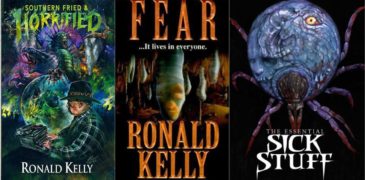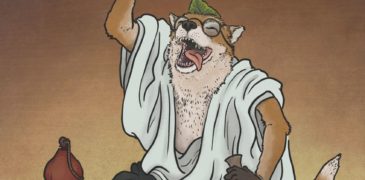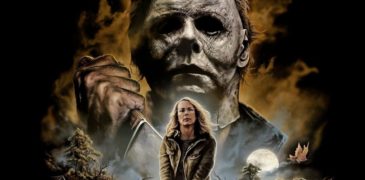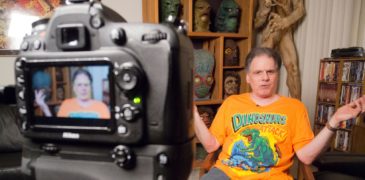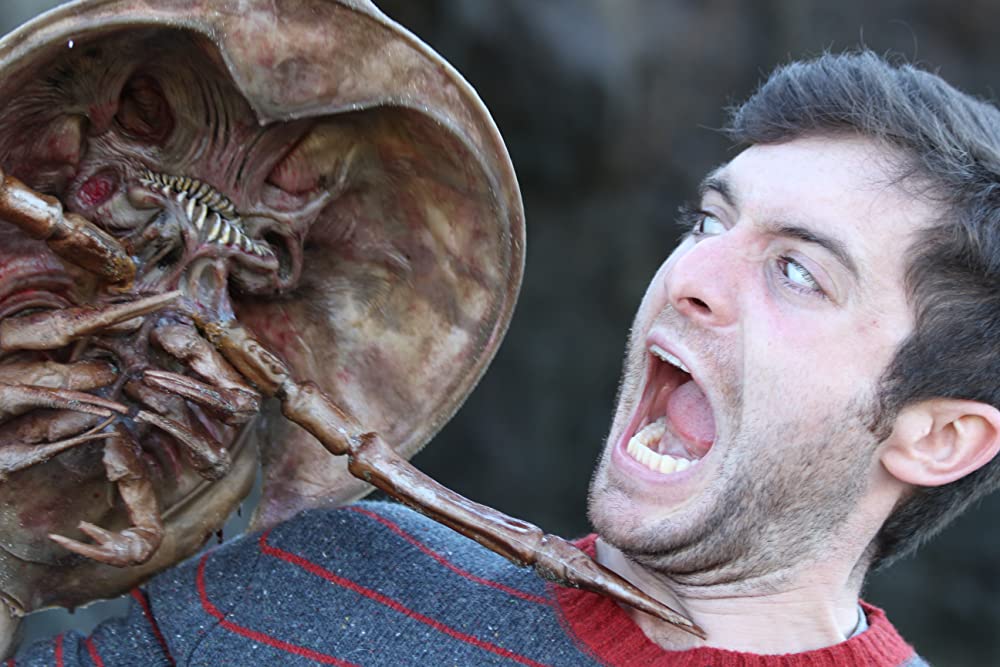
Writer/Director Pierce Berolzheimer made a show-stopping debut at this year’s Arrow Video FrightFest with the world premiere of his first feature: Crabs!. The film is a wonderfully crafted love letter to classic monster movies that exceed the trappings of other low-budget creature features with some excellent pacing and well-developed characters. You can read our full review, but the experience left us at the Grimoire of Horror excited and eager to learn more about the man behind the film and its production.
Berolzheimer was gracious enough to devote some time fielding our questions and provided some illuminating background and a wealth of interesting insight on the film itself.
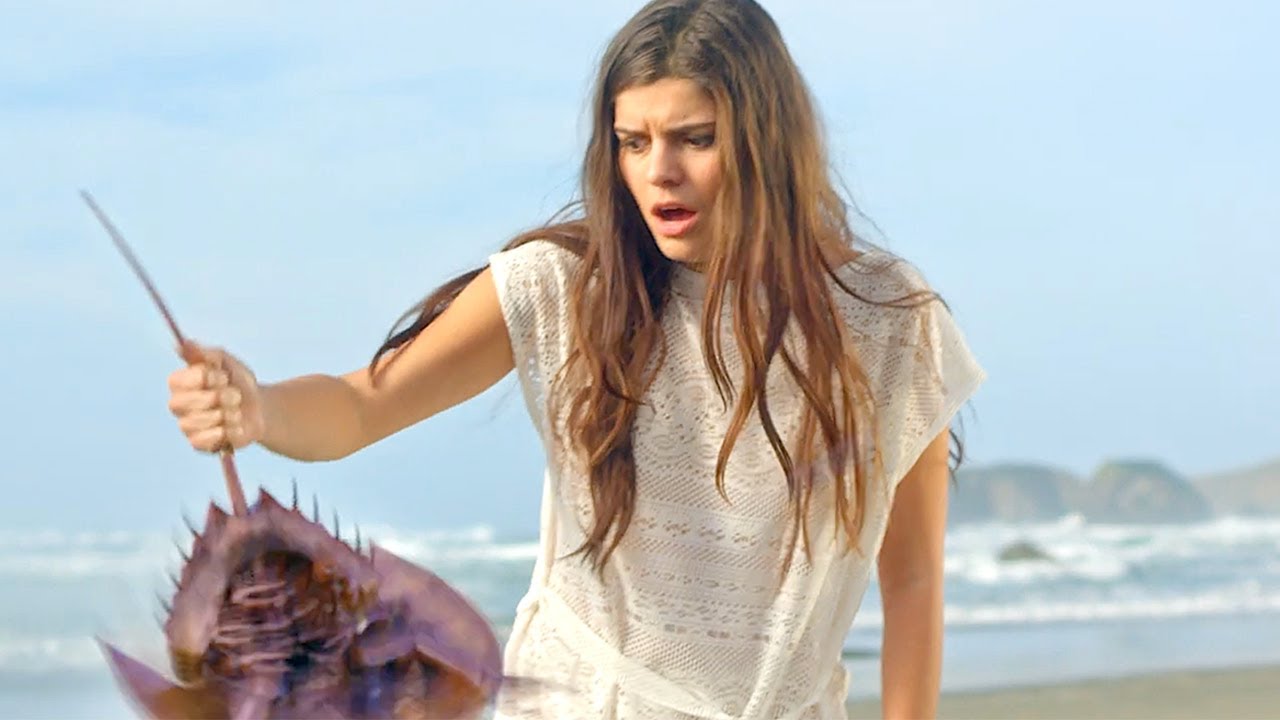
What are some of your foundational films? The movies you saw early on that really caught your attention?
PB: I’m going to go weird with this first one, but the movie Prehysteria! really stands out. I have always loved movies that are tactile – puppets, stop motion, practical effects, painted backgrounds, miniatures, all that jazz. It gives a sense of reality to the fantastical that just feels special, and Prehysteria! did a great job at that, especially for a direct-to-VHS kids movie. I didn’t even realize it had an exclamation point at the end of the title until I looked it up again, so apparently the influence runs even deeper than I thought. Prehysteria! is basically about a kid who finds mini-dinosaur eggs and the wacky antics that entails from raising pint size dinos.
As a massive Jurassic Park fan, the idea of having pet dinosaurs was beyond cool, even if I knew it was never possible in real life. I wanted to exist in that world, and it was about that time I started exploring filmmaking. I realized the only way I would ever see dinosaurs (or aliens, or monsters, or the Middle Ages) was by creating those worlds in film. Making movies to me is all about creating and then playing in worlds that cannot, or do not yet, exist. I like stories that are just outside of our own reality, offering something both recognizable and relatable, yet also foreign and magical. That’s why Prehysteria! stands out as important to me. Most of my most foundational films are that way too – The Lost Boys, Eight Legged Freaks, American Werewolf in London, Gremlins, and of course Jurassic Park.
Have you always been a horror fan? Are there any other genres that you have a particular fondness for?
PB: Yes! I grew up watching horror movies with my dad. We’d watch everything we could get our hands on, from the best of the genre to the very bottom of the barrel stuff. One of my favorite things I owned as a kid was a portable DVD player, and every day after school I would bike to our local Videoworld and rent something new. Since no one cared that a kid was renting R-rated movies back then, I watched everything I could. I’d watch all of the behind-the-scenes features too, which were always the best on horror films since you got to see how the monsters and gore were made. I continued that trend throughout college – that was basically my film education. If there is one thing I miss about our new streaming world it’s the special features on DVDs and Blu-Rays. I loved that era.
There really aren’t any genres I don’t like, but I do have a special fondness for romantic comedies. A good romantic comedy is a hard thing to find, and I can only imagine how difficult they are to get right. I don’t see myself ever attempting a full blown rom-com, but I absolutely took inspiration from them when making CRABS!. I think a lot of horror movies rely on the sex appeal of the characters to gain your sympathy, and I wanted to play with that expectation while also avoiding it like the plague. With a title like CRABS!, it makes sense to expect naked drunken teenagers being debaucherous before getting their faces eaten by crab monsters, but I didn’t want to make that movie – I wanted to tell a sweet first-love story about two friends, and also have some crabs. I wanted to subvert expectations by teasing the audience with those expected tropes, and then delivering on something a bit more heartfelt (and a bit more rom-com) instead.
What led to you getting into filmmaking?
PB: Billy Madison actually. My siblings and I knew every single word to that movie and we would use our clunky old VHS video camera to recreate the film scene by scene. We’d switch roles and take turns with the camera, but that is my earliest memory of making movies.
From there I taught myself how to make stop motion animations akin to South Park. I hated writing papers and doing homework, so as often as I could I would try and convince my teachers to let me make stop-motion animations instead of doing the assigned papers. A few relenting teachers actually agreed, so I made very crude animated adaptations of Great Expectations, The Odyssey, Beowulf, The Most Dangerous Game and The Lorax. I like to think of CRABS! as a natural progression of those films. I used similar layering techniques on the final fight of CRABS! that I had taught myself back as a kid making those early animations. I think I’ll always make very tactile movies like that.
When I got to college I still hated writing papers, so I convinced the head of the English department to let me take independent studies in filmmaking instead of the prerequisite courses. I’d strap a boom-pole to my back while shooting and directing at the same time, with no budget and way too many gory effects – it was an amazing crash course in how NOT to make movies. It was also a total blast, and I encourage everyone to just go make stuff and learn from all the failures along the way.
After college, I weaseled my way onto the set of a movie called Sun Belt Express. I started as a lowly unpaid intern and by the time we wrapped I was a Co-Producer. Afterwards I was hired onto another film with the same team, after which they asked if I had a film I’d like to make – so we made CRABS!. That’s the short version anyway.
What were some of the film inspirations going into the creation of “Crabs!”?
PB: The biggest inspiration and influence for CRABS! is Eight Legged Freaks. I absolutely love that movie, it’s highly underrated in my opinion. Until we had a composer we edited CRABS! to the Eight Legged Freaks soundtrack – it’s fantastic, I highly recommend giving it a listen. I got to see Eight Legged Freaks at a drive-in when I was a kid, and that’s how I imagine the perfect screening of CRABS! too – in the back of a car with a blanket and popcorn at the drive-ins. Eight Legged Freaks is a monster movie that takes its characters seriously, that’s sweet but edgy, and has a perfect balance between throwback and modern storytelling. I aimed to hit a very similar frequency with CRABS!.
Critters and Gremlins are also hugely inspirational. We have an entire bar scene ripped right out of Gremlins, and our little crab monsters make very similar sounds to Critters. We could have made an entire movie just about the little crabs but I also wanted to pay homage to larger monster movies like Aliens, Pumpkinhead and even tokusatsu stuff like Godzilla and Power Rangers too. CRABS! was always supposed to be a sort of ‘Greatest Hits of Monster Movies.’ Originally we had two additional set-pieces that played with slasher tropes and body horror too, but we had to cut them for budgetary reasons.

Why horseshoe crabs, specifically, for a movie monster?
PB: Four reasons actually!
1 – because I think they are the creepiest looking animals on the planet.
2 – because they are completely harmless, like the bunny in Monty Python and the Holy Grail, and I find that hilarious.
3 – because they aren’t actually crabs, so my movie CRABS! doesn’t have any actual crabs in it, which I also find totally hilarious.
4 – because I grew up going down to Little St. Simons Island in Georgia with my family and there were horseshoe crabs all over the beach. I kept waiting and waiting for someone to make a monster movie about them, but one never came, so when the time was right I just decided to make it myself.
The core cast of the film is surprisingly well developed in contrast to the disposable leads of many creature features. Was there any specific motivation behind portraying the characters this way?
PB: Thank you! That’s a huge compliment, it’s the part of the film I worked the hardest on. People expect disposable characters in horror films and I wasn’t interested in doing that. I knew the film would ride on the crab monsters alone to a certain extent, which left me free to focus on getting the relationships between the characters just right.
My motivation for the characters was simply trying to tell a compelling story while playing within the confines of the genre. I knew all of the pieces I wanted to include – the mechanical legs, the crabs, the kaiju battle, the prom – and then wrapped the character relationships and conflict around those. Trimming the fat was the most difficult part. At various points in the script we had so much character work that the crabs felt neglected, so it was a balancing act of trying to do right by the characters but also deliver the goods with the monsters.
I really wanted to avoid being emotionally exploitive too. It would have been really easy to gain sympathy for Philip if we showed a flashback of how he ended up in a wheelchair. That scene was in the original script, as was way more conflict with his brother Hunter, but in the end that felt too self-serious and we toned everything back. The interpersonal conflict was important, but I wanted it to feel real, not overly exaggerated or fabricated. For example, Philip’s conflict with his brother over selling their property is wrapped up at the end by them both sacrificing something they love for each other – in Philip’s case his workshop, and in Hunter’s case his car, both things given to them by their father (although never laid out explicitly in the film, it’s roadmapped if you look). So the conflict we set up verbally early on is resolved visually at the end without having to hammer it home, and that let the bigger conflict with the crabs take center stage.
Most everyone is based on people in my life too. Philip was based on my uncle who passed away from muscular dystrophy before I was born. He would draw giant monster battles in his school notebooks, and I always felt we were kindred spirits. The film was always meant as a gift to him, and as a way to give him back some of his power. I always knew he would be the lead character of my first film.
I also put a lot of my life and the stories I’ve collected in the film too, little moments that I think give the characters a sense of honesty. For example, when Phil and Maddy are dancing at prom and he puts his hands on her shoulders and she moves them to her hips, that was taken directly from when I danced with a girl for the first time in the 10th grade. The dead cat scene was from a story my mom told me about having to dissect a dead cat in college. Radu’s bumbling through asking Maddy to prom was a fun-house mirror version of my first attempt at asking a girl out. There are a ton of little moments or lines in the film that come from my life.
I have to ask about Radu. It just seems like there has to be some story there. What was the inspiration behind this character?
PB: Oh Radu, I love him so much. In my opinion, Chase Padgett is one of the funniest humans on the planet and Radu wouldn’t exist without him. Crafting Radu with him was one of my favorite parts of making this film.
Radu is my critique of the ‘other’ character trope – both pointing out its social problems while recognizing that we still laugh at the joke. Radu comes from nowhere, represents no one and speaks unlike anyone I’ve ever heard. He doesn’t have a family or a history in the film and exists entirely without context. Our only sense of his origin is that he says “America” like he sees it as separate from his identity and he uses made up gibberish words. I knew some people might find Radu offensive, but my question to them is who exactly is he offending? And that’s sort of the point. His closest comparison is Borat, making him a sort of simulacrum of a simulacrum. By laughing at or with Radu you’re just laughing at Radu – he points out our own comedic hypocrisy, without making us feel too much like assholes for it. The giveaway joke for this is when Radu points the drill like a gun and says “bang bang, you are different.” I wanted the audience to expect him to die because that’s what the trope demands, and the reason why I made him a hero in the end.
I know this might sound weird, but he’s also the straight man to everyone else’s crazy. In a world with gibberish energy sources, giant crab monsters, laser beams, and fourth wall breaks, Radu is the audience’s loadstone, commenting directly on the absurdity of the world along the way. In order to get the audience on board with the lack of logic in the film, we needed a seemingly illogical (although actually the most logical) character to act as their guide. He’s supposed to be the audience’s representative in the film, reacting as we would anytime the script goes off the rails.
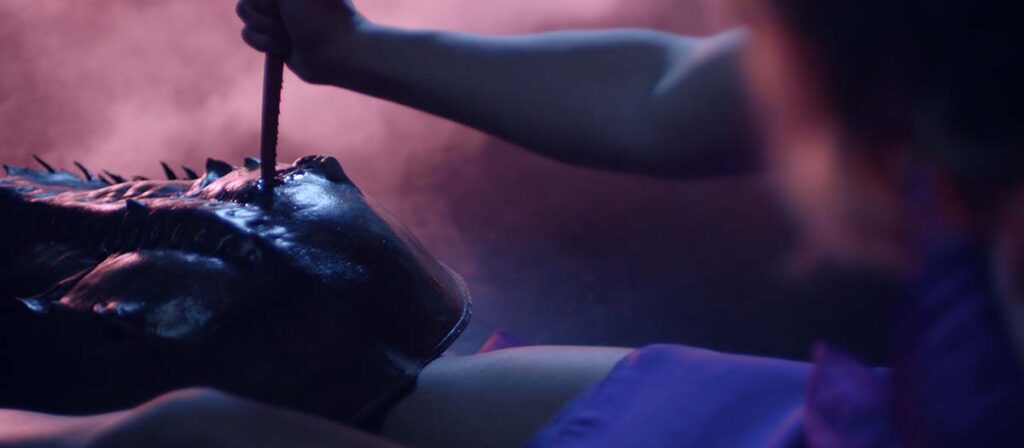
Is there any hope for a sequel? Perhaps a mecha-shark world tour?
PB: I would love to make a sequel! I have ideas for an entire CRABS! universe – sequels, prequels, spin-offs, the works! If the first one does well enough and people want more, I’d love to return to the CRABS! world.
Besides a potential sequel, what’s next? Do you have any other projects currently in development or ideas you would like to pursue for your next feature?
PB: I do have a project I’d like to get off the ground called Tithe. I’m pitching it as The Raid set in the Middle Ages.
Tithe is a (mostly) straightforward revenge story, featuring a silent protagonist (his tongue is cut out in the opening scene). I also want to incorporate horror elements and make it exceptionally brutal. I’ll be taking a lot of inspiration from S. Craig Zahler’s films for this one. He’s making some of the best films of our time in my opinion. With Tithe I want to narrow my scope, really nail the basics of a simple story and focus on directing action. I designed Tithe to take me back to the fundamentals of storytelling.
In the end though, I just want to get back on set and start directing again!
From everyone at the Grimoire of Horror, we would like to thank Pierce Berolzheimer for his time and we wish you all the best with your future projects. If you would like to follow the film in anticipation of its eventual wide release keep an eye on Raven Banner Entertainment. Pierce Berolzheimer can be found on Twitter @piberolz.
More Interviews
Ronald Kelly hails from small town Tennessee, where he was born on November 20th, 1959. Having grown up on a steady diet of EC Comics and the old Universal Monster… Mathew Meyer’s is an American artist best known for his traditional Japanese style representations of Yokai, drawn with loving detail to the woodblock printing technique of ancient Japan. Mathew regularly… “Fright-Rags is an American company known for releasing apparel based on horror films and other horror-related media. The company was founded in 2003 by Ben Scrivens, and is based in… Gary Gerani is a professional fiction/non-fiction writer and film critic from Brooklyn, New York. As a screenwriter, he is best known for creating and co-authoring the screenplay for Stan Winston’s…Southern-Fried Fear – An Interview with Ronald Kelly
Interview: Matthew Meyer “There’s Essentially a Yokai for Every Occasion”
Interview With Ben Scrivens of Fright-Rags (Video Content)
Gary Gerani Interview – Screenwriter of Pumpkinhead (1988)
Dustin is a potentially overqualified office worker who has a lifelong love and fascination with Japan and all things Horror. With a bachelor’s in English Literature and a master’s in Library Science, he devotes way too much time to researching and thinking critically about the media he enjoys. When not celebrating trashy horror films, anime, and idol music, he can be found raving about all things genre cinema as a co-host on Genre Exposure: A Film Podcast or indulging a passion for storytelling through tabletop roleplaying games.
